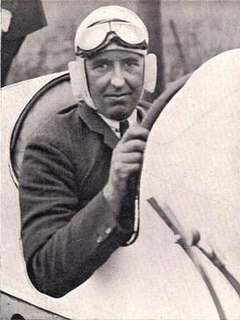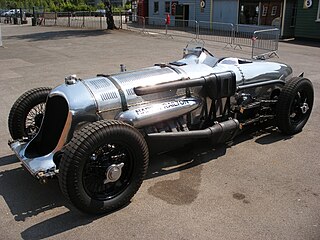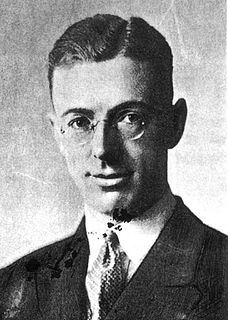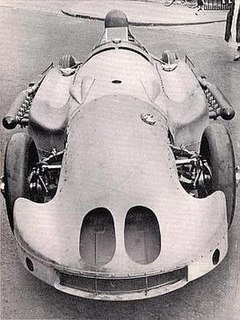
The Napier Lion was a 12-cylinder, petrol-fueled 'broad arrow' W12 configuration aircraft engine built by D. Napier & Son from 1917 until the 1930s. A number of advanced features made it the most powerful engine of its day and kept it in production long after other contemporary designs had been superseded. It is particularly well known for its use in a number of racing designs, for aircraft, boats and cars.

The land speed record is the highest speed achieved by a person using a vehicle on land. There is no single body for validation and regulation; in practice the Category C flying start regulations are used, officiated by regional or national organizations under the auspices of the Fédération Internationale de l'Automobile (FIA). The land speed record (LSR) is standardized as the speed over a course of fixed length, averaged over two runs. Two runs are required in opposite directions within one hour, and a new record mark must exceed the previous one by at least one percent to be validated.

D. Napier & Son Limited was a British engineering company best known for its luxury motor cars in the Edwardian era and for its aero engines throughout the early to mid-20th century.

Craig Breedlove is an American professional race car driver and a five-time world land speed record holder. He was the first person in history to reach 500 mph (800 km/h), and 600 mph (970 km/h), using several turbojet-powered vehicles, all named Spirit of America.

Spirit of America is the trademarked name used by Craig Breedlove for his land speed record-setting vehicles.

John Rhodes Cobb was an early to mid 20th Century English racing motorist. He was three times holder of the World Land Speed Record, in 1938, 1939 and 1947, set at Bonneville Speedway in Utah, US. He was awarded the Segrave Trophy in 1947. He was killed in 1952 whilst piloting a jet powered speedboat attempting to break the World Water Speed Record on Loch Ness water in Scotland.

The Arab was a high-performance English automobile designed by Reid Railton and manufactured in Letchworth, Hertfordshire, between 1926 and 1928. The factory had previously been used by the Phoenix car company.

John Godfrey Parry-Thomas was a Welsh engineer and motor-racing driver who at one time held the land speed record. He was the first driver to be killed in pursuit of the land speed record.

The Napier-Railton is an aero-engined race car built in 1933, designed by Reid Railton to a commission by John Cobb, and built by Thomson & Taylor. It was driven by Cobb, mainly at the Brooklands race track where it holds the all-time lap record which was set in 1935. The circuit was appropriated for military purposes during the Second World War, and never reopened in that form for racing. It has a W12 engine with 3 different exhaust systems.

Reid A. Railton (1895–1977) was a British automotive engineer, and designer of land and water speed record vehicles.

The Rolls-Royce R was a British aero engine designed and built specifically for air racing purposes by Rolls-Royce Limited. Nineteen R engines were assembled in a limited production run between 1929 and 1931. Developed from the Rolls-Royce Buzzard, it was a 37-litre capacity, supercharged V-12 capable of producing just under 2,800 horsepower (2,090 kW), and weighed 1,640 pounds (770 kg). Intensive factory testing revealed mechanical failures which were remedied by redesigning the components, greatly improving reliability.

The Mercedes-Benz T80 was a six-wheeled vehicle built by Mercedes-Benz, developed and designed by Ferdinand Porsche. It was intended to break the world land speed record, but never made the attempt, the project having been overtaken by the outbreak of World War II.

Ernest Arthur Douglas Eldridge was a British racing car driver who broke the world land speed record in 1924. His was the last land speed record set on an open road.

Thunderbolt was a British Land Speed Record holder of the 1930s, driven by Captain George E.T. Eyston.

Captain George Edward Thomas Eyston MC OBE was a British engineer, inventor, and racing driver best known for breaking the land speed record three times between 1937 and 1939.

The Bluebird-Proteus CN7 is a gas turbine-powered vehicle that was driven by Donald Campbell and achieved the world land speed record on Lake Eyre in Australia on 17 July 1964. The vehicle set the FIA world record for the flying mile at 403.1 mph (648.7 km/h).

Speed of the Wind was a record-breaking car of the 1930s, built for and driven by Captain George Eyston.
The Magic Midgets were a number of record-breaking 750cc "midget" MG cars of the 1930s. They were most notably, but not always, driven by George Eyston.

An aero-engined car is an automobile powered by an engine designed for aircraft use. Most such cars have been built for racing, and many have attempted to set world land speed records. While the practice of fitting cars with aircraft engines predates World War I by a few years, it was most popular in the interwar period between the world wars when military-surplus aircraft engines were readily available and used to power numerous high-performance racing cars. Initially powered by piston aircraft engines, a number of post-World War II aero-engined cars have been powered by aviation turbine and jet engines instead. Piston-engined, turbine-engined, and jet-engined cars have all set world land speed records. There have also been some non-racing automotive applications for aircraft engines, including production vehicles such as the Tucker 48 and prototypes such as the Chrysler Turbine Car, Fiat Turbina, and General Motors Firebirds. In the late 20th century and into the 21st century, there has also been a revival of interest in piston-powered aero-engined racing cars.
Land speed racing is a form of motorsport.




















